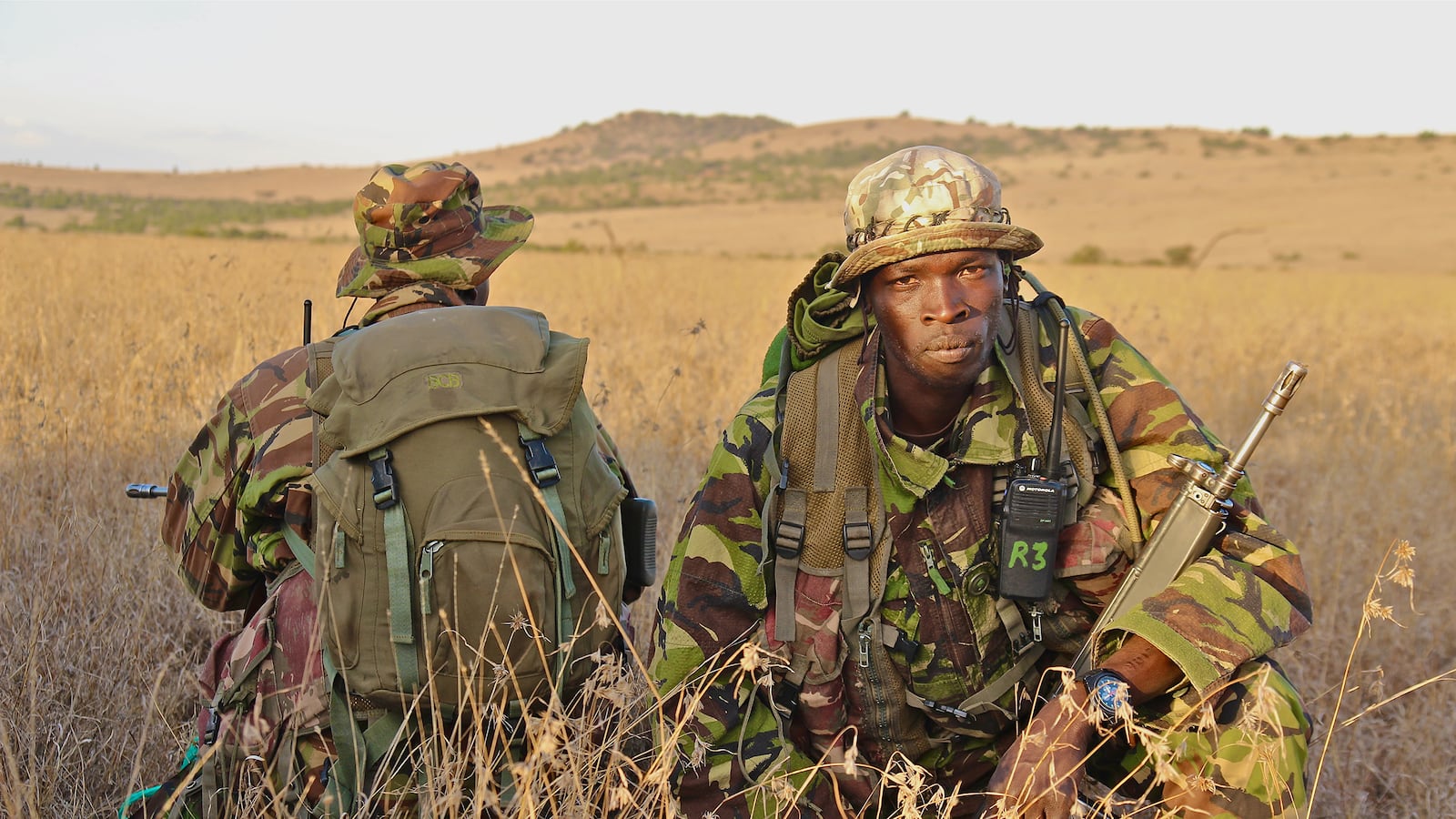The black rhinoceros has roamed the earth for five million years, yet it is now facing the greatest threat in its history, from poaching. According to the International Union for Conservation of Nature, the animal is “teetering on the brink of extinction.” There are just over 5,000 left in the wild in Africa; in Kenya alone, 48 were killed during 2013.

Last week, the world’s largest conference on the illegal wildlife trade was convened in London, attended by leading conservationists together with the Prince of Wales and his son, Prince William. Forty-six countries agreed to take steps to counter the trade in a declaration, which recognized that poaching had reached “unprecedented levels” and that there is now a “serious threat to the survival of many species if action is not taken.” In a campaign video filmed with soccer player David Beckham and the former NBA basketball star Yao Ming, Prince William said, “When the buying stops, the killing can too.”
One organization that has entered the rhino conservation fray is Borana, a conservancy, cattle ranch, and high-end tourist lodge in northern Kenya, which recently became the world’s newest rhino sanctuary. Its owner, Michael Dyer, is passionate about the positive contribution – not least of which is financial – that tourists to Borana can have on rhino preservation. “Rhino need all the help they can get,” he told me, during a week on the ranch learning about the important integration of tourism and conservation, and the military training their rangers are put through in order to counter sophisticated poaching methods.
The sun was lowering over Kenya’s high country when the camouflage-clad rangers leaped from the back of the jeep, Heckler & Koch rifles at the ready, canvas rucksacks containing night-vision goggles on their backs.

They landed quietly in a sea of silver grass and crouched in perfect formation—one facing north, the other due south—scanning the perimeter fences of Borana. We were alone, apart from a warthog that scuttled across the sunbaked road, but that didn’t mean poachers weren’t observing us from afar. The rangers’ charges are the twenty-one critically endangered Black rhinos that had been introduced to the rolling hills of Borana.
Sam Taylor, Borana’s chief conservation officer, issued final instructions to the rangers in Swahili, and then we drove away across the darkening plains. He was nervous: the rangers were highly trained, but through the windscreen we could see a quarter-moon rising over the jagged summits of Mount Kenya.
“That’s the problem,” he said, pointing to the moon. “And it’s getting bigger.” In a few days’ time the moon would be full. It is known as a “killer’s moon,” the ideal time for rhino poaching.
Initially, poachers wanted the rhino horns for their keratin, which would be powdered and sold on the black market in far-east Asia as a cure for a range of ailments, from food poisoning to strokes and hangover cures. For thousands of years, the material also featured in Traditional Chinese medicine. More recently, a Vietnamese politician allegedly claimed that treatment with rhino horn had cured him of cancer, although it has been tested as a medicine and found to have no medical properties. And, according to Cathy Dean, Director of Save the Rhino International, an entirely new use of rhino horn has recently emerged: in Vietnam, it is preserved whole and displayed as a status object.
Today, rhino horn fetches approximately $65-70,000 per kg, making it worth more than gold on the black market. Poaching is a big and dirty business. Even worse, poachers have links to international drug, arms, and human trafficking crime syndicates, and criminal links have also been found to Al Shabaab, a militant cell of al-Qaeda based in southern Somalia. It is an international environmental crime that Interpol has referred to as “one that can affect a nation’s economy, security and even its existence.”
Borana is owned by the Dyers, an old settler family, who have been working to preserve their patch of African beauty for three generations. Positioned on the high plains of the Laikipi Plateau, which skirts the wild and little-visited Northern Frontier District, Borana was originally a cattle and sheep ranch. In 1992, Dyer, the third-generation owner, made wildlife his primary focus and, soon after, built Borana Lodge, a high-end collection of thatched cottages built into the hillside.
The family’s ethos is humbling: they only see themselves as the guardians of their land, not the owners, and believe they have a responsibility to maintain its ecological integrity. “As the keepers of these wildernesses we must make them available to the animals that need them the most,” Dyer’s brother, Fuzz Dyer, said. Borana is still a working ranch, with two thousand Boran cattle living successfully among lions, elephants, wild dogs and, since August 2013, twenty-one Black rhinos.
The rhino had traveled overnight from neighboring Lewa Wildlife Conservancy - where the sanctuary had bred them so successfully they had exceeded their “carrying capacity” – and Lake Nakuru National Park. In the process of moving the animals, a tracking device was inserted into each of their posterior horns and a distinct pattern of notches cut into one ear. Finally, much of the rhinos’ anterior horns were removed in the hopes of discouraging potential poachers from killing them.
At first light one morning, Taylor drove two keen rhino-spotting guests and me to the top of Samangua Hill, one of Borana’s highest points. We were hoping to see Songa, who’s name means “to move,” and who was the first black rhino to move to Borana. At this time of day the air at 6,200 feet was cool, and the peaks of Mt. Kenya were clear. Egyptian geese were flocking on the shores of the lake, a reticulated giraffe ambled slowly through the valley, and woodpeckers sang from the yellow fever trees.

The views from Samangua were breathtaking. In every direction there were wide skies, gold grass hills and acacia trees. East of Borana stretched Lewa’s open savannah, beyond which we could see the hazy blue layers of the Matthews Range. To the north lay the wide expanse of Samburu land, and its mighty Ewaso Ngiro river. And just below us, somewhere among the candelabra and euphorbia trees, were a handful of Diceros bicornis: the black rhino.
Taylor wanted to check a few males who had apparently been “scrapping,” and asked us to assist him in gathering telemetry data for the daily Rhino News email. Holding a portable antenna high over his head, he surveyed the area as it emitted a series of telling bleeps.
“Hmm, number 9 should be the other side of the hills,” he said, following a loud bleep, and asked me to jot down its GPS coordinates. Then came a quieter bleep, as he tuned into another rhino’s transmitter: a female, some distance away. “Good, number 15 – she and her calf are still in the same place,” he said. He tried another, and the bleep this time was far more insistent (and more alarming). “Ah. Number 13 is very close!” I knew that Black rhino tend to be more aggressive than White, and I felt a fleeting sense of vulnerability. But number 13 remained deep in the bush.
Guests at Borana have the opportunity to help with rhino conservation tasks, from telemetry work and accumulating behavioral information, to providing visuals of rhino from their morning game drives. Every piece of data is useful and goes towards building individual histories. “It all helps to remove the guess work,” said Sam, as, back in his office, he plotted the coordinates into a digital map of the conservancy. Another crucial long-term plan is to get the rhino breeding again. “We are reaching a point where deaths from poaching and natural mortality are overtaking the birth rate,” Cathy Dean said.
Later that day, as rain moved like a thin gauze curtain over the distant Nanyuyki plain and night fell quickly (Borana is only 17 miles north of the Equator), I met the British ex-SAS Warrant Officer, Pete (who for security reasons can only be identified by his first name), who has been training Borana’s 100 plus anti-poaching security team. I hadn’t anticipated how much like an army camp the training site would look, or the extent to which the effort against rhino and elephant poaching is being militarized.
Pete ran through the rangers’ training drills: apart from fitness exercises, their regime includes: basic patrol tactics, navigation skills, night tactics, and aviation and evacuation training. Some are taught to handle bloodhounds and the aggressive Belgian Malinois attack dogs, while one man per patrol has advanced medical training. Recruits acquire Kenyan Police Reservist status once they have completed the course, which allows them to carry arms. Rianto, one of Taylor’s local Masai scouts, told me that the training was “hard, very hard … because in reality it’s a matter of life and death,” but that the regime meant they were “ready for them, if [the poachers] come.”
These men are Borana’s trusted eyes and ears. Unfortunately, a ranger can also prove to be the enemy within: much of the rhino poaching in Africa has occurred as a direct result of “inside” intelligence, so keeping rangers loyal is fundamental. “We discuss the dangers of becoming involved in the criminal underworld, of going over to the dark side,” Taylor said. “We emphasize that the poachers are not good guys.”
Borana provides the rangers with a generous package of benefits including health care and educational support for their families. If the men run into financial straits—the time when rangers are likely to weaken and be tempted by a lucrative bribe from poaching cartels—Borana can help out. It is, in part, an exercise in clever man-management.

Taylor also emphasizes to his rangers that in guarding black rhino they are part of a long-term mission and that the elements of tourism, wildlife, and community are fundamentally interconnected. Tourism accounts for 40 percent of Kenya’s GDP, and is largely based on wildlife. “It’s about understanding the connection between a tourist looking at an animal, and the flow of tourist money that goes to wildlife and the wider community,” Taylor said. If elephant, rhino, and other African wildlife are poached to extinction, tourism will dry up. “No tourist is going to fly out here to look at grass,” Pete said.
Somewhere in the basalt hills a lion roared, the sound carrying through the night until another responded. It was a timely reminder that the rangers are not just contending with reckless poachers carrying AK-47 assault rifles, but African predators. Three-man patrol teams and a rapid-reaction unit are out all night, in addition to the daytime scouts who track rhino conventionally across Borana’s 32,000 acres.
Looking after the world’s remaining black rhino has become a round-the-clock job. “It is the sad reality of man’s greed and folly that rhino now have to be under 24 hour surveillance,” said Charlie Mayhew, the CEO of Tusk Trust. In recent press articles there have been references to the increasingly sophisticated tactics and weaponry poachers are using, but Pete dismissed them. “You don’t need to be a rocket scientist to poach a rhino,” he said. “You just need to breach a fence and know their browsing areas.” Rhino tend to stick close to their “middens”—dung piles—and this predictably makes them even more vulnerable.
On the hood of the jeep, Taylor and Pete unfold a map of the rangers’ night operations and study it with a torch. Their language is peppered with military speak. Borana is fighting a war, but they are not battling it alone. They are collaborating with other rhino conservancies such as Lewa Wildlife Conservancy, Ol Pejeta Conservancy, and Ol Jogi Wildlife Conservancy in sharing intelligence, training, resources, and expertise. “The key is to get everyone singing from the same song sheet,” says Pete. “It is the only way we’re going to win this. You can’t just sit in your own garden and look over the fence.”
It is a metaphor for the importance of collaboration, but in early 2014 the fence that separates Borana and Lewa, two of the world’s richest and most diverse ecosystems, will come down, creating one contiguous ecosystem. “The whole objective is to run one big rhino sanctuary,” Dyer said. “It makes no sense at all to have one rhino sanctuary next to another.”
The day before I left Borana, we found a female rhino—the now infamous “no. 15”—pulling at wait-a-bit thorn with her hooked upper lip. This number, sprayed in white on her rump, was still visible in the first light of day, and we were close enough to see the thick folds of skin around her ribcage, and her leaf-shaped ears as they twitched to the rumble of our engine. At her side was her calf, which turned and squinted at us through baby eyes. “It is an honor to defend something that can’t defend itself,” Taylor said, neatly summing up the philosophy of the committed team at Borana.
If Black rhino were to become another creature on the growing list of extinct species, it would be a loss for us all. As Dyer’s father wrote, "Man and microbe, rhino and rose—we all have a shared destiny.” Dyer is unequivocal about the moral imperative of protecting rhino, even though the costs and challenges are huge. “It’s up to us,” he told me. “We have a moral obligation to the next generation to get it right. Even if it bankrupts us.”






